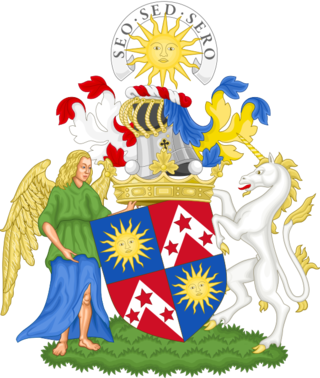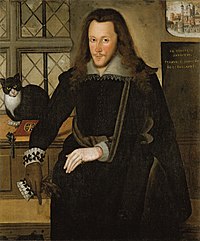Duke of Newcastle upon Tyne was a title that was created three times, once in the Peerage of England and twice in the Peerage of Great Britain. The first grant of the title was made in 1665 to William Cavendish, 1st Marquess of Newcastle upon Tyne. He was a prominent Royalist commander during the Civil War.

Duke of Bedford is a title that has been created six times in the Peerage of England. The first and second creations came in 1414 and 1433 respectively, both in favour of Henry IV's third son, John, who later served as regent of France. He was made Earl of Kendal at the same time and was made Earl of Richmond later the same year. The titles became extinct on his death in 1435. The third creation came in 1470 in favour of George Neville, nephew of Warwick the Kingmaker. He was deprived of the title by Act of Parliament in 1478. The fourth creation came in 1478 in favour of George, the third son of Edward IV. He died the following year at the age of two. The fifth creation came in 1485 in favour of Jasper Tudor, half-brother of Henry VI and uncle of Henry VII. He had already been created Earl of Pembroke in 1452. However, as he was a Lancastrian, his title was forfeited between 1461 and 1485 during the predominance of the House of York. He regained the earldom in 1485 when his nephew Henry VII came to the throne and was elevated to the dukedom the same year. He had no legitimate children and the titles became extinct on his death in 1495.

Thomas Wriothesley, 1st Earl of Southampton, KG was an English peer, secretary of state, Lord Chancellor and Lord High Admiral. A naturally skilled but unscrupulous and devious politician who changed with the times, Wriothesley served as a loyal instrument of King Henry VIII in the latter's break with the Catholic church. Richly rewarded with royal gains from the Dissolution of the Monasteries, he nevertheless prosecuted Calvinists and other Protestants when political winds changed.

Marquess of Lothian is a title in the Peerage of Scotland, which was created in 1701 for Robert Kerr, 4th Earl of Lothian. The Marquess of Lothian holds the subsidiary titles of Earl of Lothian, Earl of Lothian, Earl of Ancram (1633), Earl of Ancram, Viscount of Briene (1701), Lord Newbattle (1591), Lord Jedburgh (1622), Lord Kerr of Newbattle (1631), Lord Kerr of Nisbet, Langnewtoun, and Dolphinstoun (1633), Lord Kerr of Newbattle, Oxnam, Jedburgh, Dolphinstoun and Nisbet (1701), and Baron Ker, of Kersheugh in the County of Roxburgh (1821), all but the last in the Peerage of Scotland. As The Lord Ker in the Peerage of the United Kingdom, previous marquesses sat in the House of Lords before 1963, when Scottish peers first sat in the House of Lords in their own right. The holder of the marquessate is also the Chief of Clan Kerr.

Earl of Westmorland is a title that has been created twice in the Peerage of England. The title was first created in 1397 for Ralph Neville. It was forfeited in 1571 by Charles Neville, 6th Earl of Westmorland, for leading the Rising of the North. It was revived in 1624 in favour of Sir Francis Fane, whose mother, Mary Neville, was a descendant of a younger son of the first Earl. The first Earl of the first creation had already become Baron Neville de Raby, and that was a subsidiary title for his successors. The current Earl holds the subsidiary title Baron Burghersh (1624).

Marquess of Exeter is a title that has been created twice, once in the peerage of England and once in the peerage of the United Kingdom. The first creation came in the peerage of England in 1525 for Henry Courtenay, 2nd Earl of Devon. For more information on this creation, which was forfeited in 1538, see Earl of Devon.

Baron FitzWalter is an ancient title in the Peerage of England. It was created on 24 June 1295 for Robert FitzWalter. The title was created by writ, which means that it can descend through both male and female lines.

Earl of Westmeath is a title in the Peerage of Ireland. It was created in 1621 for Richard Nugent, Baron Delvin. During the Tudor era the loyalty of the Nugent family was often in question, and Richard's father, the sixth Baron, died in prison while awaiting trial for treason, a crime for which other members of the family had already been condemned. Richard himself when young was suspected of plotting rebellion and was imprisoned, but in later life, he was a staunch supporter of the Crown, which rewarded him richly for his loyalty. The fifth Earl was a Major-General in the British Army. The sixth Earl was sworn of the Irish Privy Council in 1758. His son by his first wife, Richard Nugent, Lord Delvin, was killed in a duel at an early age. Lord Westmeath was succeeded by his second son by his second wife, the seventh Earl. He sat in the House of Lords as one of the original 28 Irish Representative Peers; he was also involved in a much-publicised divorce following an action for criminal conversation against his wife and her lover. He was succeeded by his son, the eighth Earl. He was created Marquess of Westmeath in the Peerage of Ireland in 1822. He had no surviving male issue and the marquessate became extinct on his death in 1871. He was succeeded in the barony and earldom by his kinsman, Anthony Francis Nugent, the ninth Earl, who was a claimant to the title Baron Nugent of Riverston. The eleventh Earl was an Irish Representative Peer from 1901 to 1933.
Baron Kerry is an ancient title in the Peerage of Ireland named after County Kerry. It was created circa 1223 for Thomas FitzMaurice, Lord OConnello, son of Maurice FitzGerald, Lord of Llanstephan.

Earl of Chichester is a title that has been created three times, twice in the Peerage of England and once in the Peerage of the United Kingdom. The current title was created in the Peerage of the United Kingdom in 1801 for Thomas Pelham, 2nd Baron Pelham of Stanmer.

Henry Wriothesley, 3rd Earl of Southampton, was the only son of Henry Wriothesley, 2nd Earl of Southampton, and Mary Browne, daughter of Anthony Browne, 1st Viscount Montagu. Shakespeare's two narrative poems, Venus and Adonis and The Rape of Lucrece, were dedicated to Southampton, who is frequently identified as the Fair Youth of Shakespeare's Sonnets.

Baron Montagu of Beaulieu, in the County of Hampshire, is a title in the Peerage of the United Kingdom. It was created in 1885 for the Conservative politician Lord Henry Montagu Douglas Scott, who had earlier represented Selkirkshire and South Hampshire in the House of Commons. He was the second son of Walter Montagu Douglas Scott, 5th Duke of Buccleuch. His son, the second Baron, sat as a Conservative Member of Parliament for New Forest. The 3rd Baron Montagu of Beaulieu was one of the ninety elected hereditary peers that remain in the House of Lords after the passing of the House of Lords Act 1999, and sat on the Conservative benches. As descendants of the 5th Duke of Buccleuch, the Barons Montagu of Beaulieu are also in remainder to this peerage and its subsidiary titles.

Earl or Lord of Clanricarde is a title that has been created twice in the Peerage of Ireland, first in 1543 and again in 1800. The former creation became extinct in 1916 while the 1800 creation is extant and held by the Marquess of Sligo since 1916.

Thomas Wriothesley, 4th Earl of Southampton, KG, styled Lord Wriothesley before 1624, was an English statesman, a staunch supporter of King Charles II who after the Restoration of the Monarchy in 1660 rose to the position of Lord High Treasurer, which term began with the assumption of power by the Clarendon Ministry. He "was remarkable for his freedom from any taint of corruption and for his efforts in the interests of economy and financial order", a noble if not a completely objective view of his work as the keeper of the nation's finances. He died before the impeachment of Lord Clarendon, after which the Cabal Ministry took over government.

Edward Fiennes, or Clinton, 1st Earl of Lincoln KG was an English landowner, peer, and Lord High Admiral. He rendered valuable service to four of the Tudor monarchs.
This is a list of people who have served as Custos Rotulorum of Hampshire.

Henry Wriothesley, 2nd Earl of Southampton, was an English peer.

Elizabeth Wriothesley, Countess of Southampton was one of the chief ladies-in-waiting to Elizabeth I of England in the later years of her reign.
Wriothesley may refer to:

Sir John Chichester (1519/20-1569) of Raleigh in the parish of Pilton, near Barnstaple in North Devon, was a leading member of the Devonshire gentry, a naval captain, and ardent Protestant who served as Sheriff of Devon in 1550-1551, and as Knight of the Shire for Devon in 1547, April 1554, and 1563, and as Member of Parliament for Barnstaple in 1559, over which borough his lordship of the manor of Raleigh, Pilton had considerable influence.














